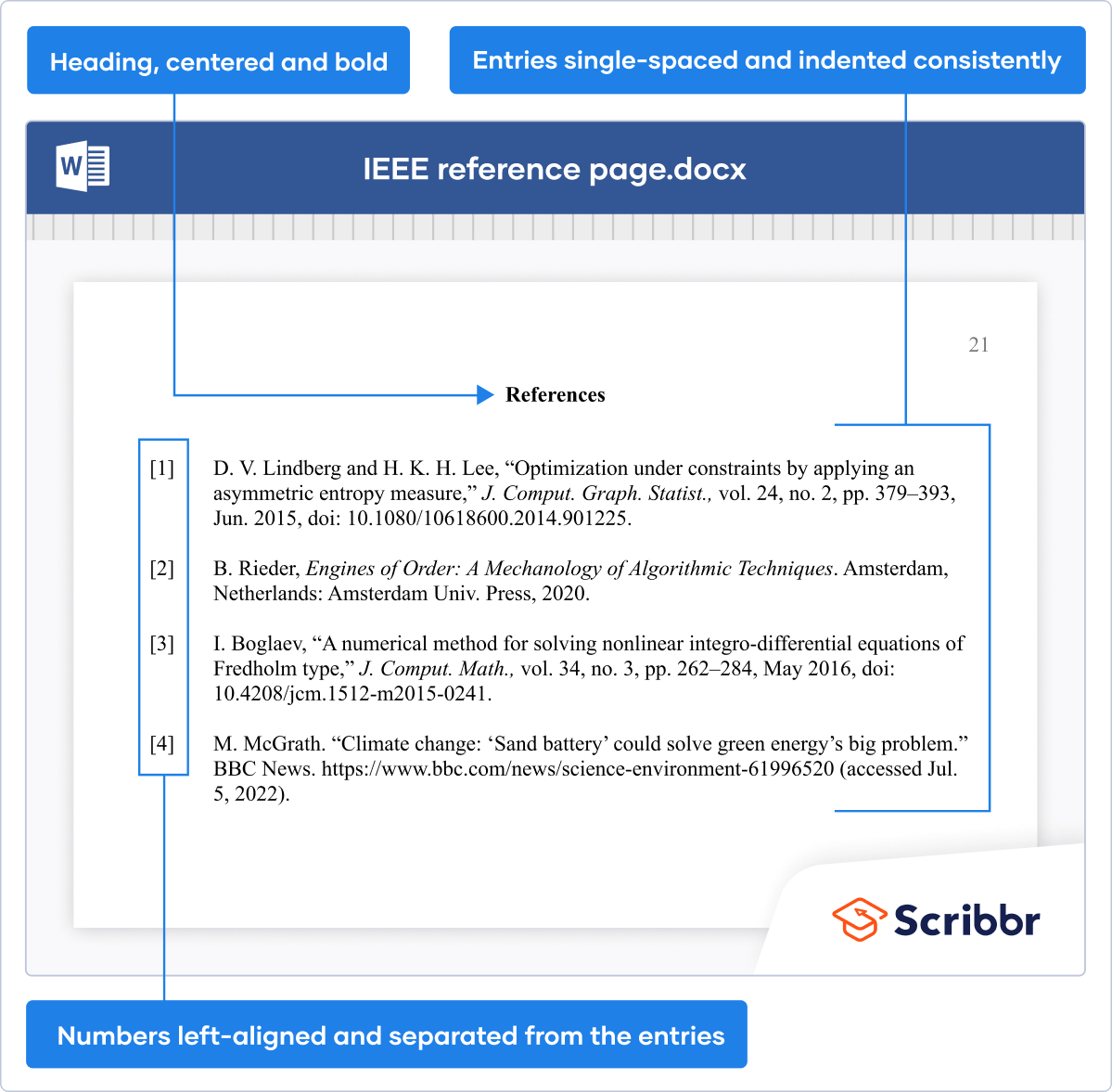IEEE Citation | Quick Guide & Examples
IEEE citation format is a way of citing your sources in a paper. IEEE stands for the Institute of Electrical and Electronics Engineers, the association that created the guidelines.
It is a commonly used citation style in electrical and electronic engineering, in computer science, and in other technical disciplines. It is also used in IEEE’s own publications.
IEEE citation format consists of:
- Numerical in-text citations appearing in brackets
- A numbered reference list with full source information
| IEEE in-text citation | Further discussion of constrained optimization can be found in Lindberg and Lee [1]. |
|---|---|
| IEEE reference | [1] D. V. Lindberg and H. K. H. Lee, “Optimization under constraints by applying an asymmetric entropy measure,” J. Comput. Graph. Statist., vol. 24, no. 2, pp. 379–393, Jun. 2015, doi: 10.1080/10618600.2014.901225. |
IEEE in-text citation
An IEEE in-text citation is just a number in brackets, pointing the reader to the relevant reference. Use the same number each time if you refer to the same source repeatedly. You may also mention the author’s name in your sentence, but you don’t have to.
IEEE citations can be placed at the relevant point in the sentence, before any punctuation that follows. Multiple citations at the same point are separated by commas, a range of citations by an en dash (–, outside the brackets, with no spaces).
A more concise option is to treat the citations as nouns in your sentence, in which case you don’t mention any author names. If you take this approach, be consistent. Don’t switch between the two approaches in one paper.
If you quote or paraphrase a specific part of the source, include a page number within the brackets to point the reader to the right part.
IEEE references
The IEEE reference page provides full information on your sources, so that readers can locate and consult them. You’ll usually include the author’s name, the title of the source, the publication date, and information about the publisher.
The exact information included and the formatting vary by source type. Formats and examples for common source types are shown below.
| IEEE book citation format | Author initial. Last name, Book Title. City (and state if in US), Country: Publisher, Year. |
|---|---|
| IEEE reference | B. Rieder, Engines of Order: A Mechanology of Algorithmic Techniques. Amsterdam, Netherlands: Amsterdam Univ. Press, 2020. |
| IEEE journal article citation format | Author initial. Last name, “Article title,” Journal Name, vol. Volume, no. Number, pp. Page range, Month Year, DOI. |
|---|---|
| IEEE reference | I. Boglaev, “A numerical method for solving nonlinear integro-differential equations of Fredholm type,” J. Comput. Math., vol. 34, no. 3, pp. 262–284, May 2016, doi: 10.4208/jcm.1512-m2015-0241. |
| IEEE website citation format | Author initial. Last name. “Page title.” Website Name. URL (accessed Month Day, Year). |
|---|---|
| IEEE reference | M. McGrath. “Climate change: ‘Sand battery’ could solve green energy’s big problem.” BBC News. https://www.bbc.com/news/science-environment-61996520 (accessed Jul. 5, 2022). |
Formatting the reference page
The IEEE reference page appears on a separate page at the end of your paper, with the heading “References” at the top. The heading is written in bold text, either left-aligned or centered.
References are numbered in the order they were first cited in the text. The numbers appear in brackets on the left side of the page, forming their own column separate from the references, which are indented consistently.
The references are single-spaced, with the next reference appearing on the following line.
Frequently asked questions about IEEE citation
- Who uses IEEE citation format?
-
IEEE citation format is defined by the Institute of Electrical and Electronics Engineers and used in their publications.
It’s also a widely used citation style for students in technical fields like electrical and electronic engineering, computer science, telecommunications, and computer engineering.
- How do I create IEEE in-text citations?
-
An IEEE in-text citation consists of a number in brackets at the relevant point in the text, which points the reader to the right entry in the numbered reference list at the end of the paper. For example, “Smith [1] states that …”
A location marker such as a page number is also included within the brackets when needed: “Smith [1, p. 13] argues …”
- How do I format the IEEE reference page?
-
The IEEE reference page consists of a list of references numbered in the order they were cited in the text. The title “References” appears in bold at the top, either left-aligned or centered.
The numbers appear in square brackets on the left-hand side of the page. The reference entries are indented consistently to separate them from the numbers. Entries are single-spaced, with a normal paragraph break between them.
